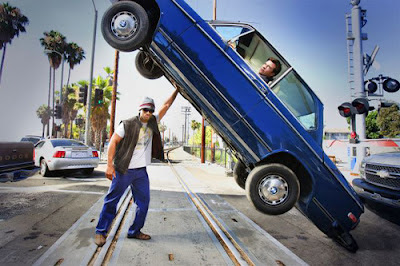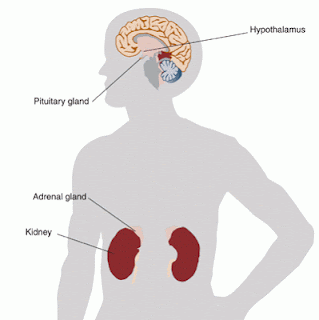Angela dashed outside to see her unconscious son trapped under the car. She yelled for a neighbor to get help but it was taking too long, so she took matters into her own hands. Literally. She proceeded to lift the car—high enough to replace the jacks—and pull Tony out from beneath.
Yep, you read that correctly. She lifted a 3,500-pound car from the ground.
There's not much more information to be found about Mrs. Cavallo aside from this incredible story, but I'll safely assume she wasn't a body builder. In fact, I'll bet the same for the other individuals who have also demonstrated this sort of "hysterical strength." But that's beside the point—if you were placed in a similar situation, you could probably lift a car, too!
It's all thanks to the handy little hormone called adrenaline.
Activating the stress response
The kicker about this incredible and unnatural power is that it's not recognized by medical science.
This so-called hysterical strength that we may somehow tap into during high-stress situations cannot be reproduced in a laboratory setting—not only would it be dangerous and unethical, but no controlled situation is likely to induce it. As such, we are simply left with interesting news stories and extreme curiosity: how is this even possible?

The theory behind this super-human strength is that we typically only use a small percentage of our muscles' capabilities. When adrenaline is pumped into our circulation, blood is shunted away from our guts (who needs to digest food during a fearful situation, anyway?) and to our muscles. This, in turn, means more oxygen gets to our muscles. Adrenaline also facilitates the conversion of our body's stored energy source, glycogen, to fuel in the form of glucose. The combination of increased oxygen and energy levels strengthens our muscles beyond normal levels.
Hoh JF, Rossmanith GH, Kwan LJ, & Hamilton AM (1988). Adrenaline increases the rate of cycling of crossbridges in rat cardiac muscle as measured by pseudo-random binary noise-modulated perturbation analysis. Circulation research, 62 (3), 452-61 PMID: 3342474
This so-called hysterical strength that we may somehow tap into during high-stress situations cannot be reproduced in a laboratory setting—not only would it be dangerous and unethical, but no controlled situation is likely to induce it. As such, we are simply left with interesting news stories and extreme curiosity: how is this even possible?
During a stressful or fearful situation—such as, well, seeing your son pinned beneath a car—the hypothalamus is activated. The hypothalamus is chiefly responsible for maintaining the body's homeostasis, or stable physiological balance. It's involved in such behaviors as eating, body temperature regulation, and—in this case—the body's balance between stress and relaxation. The latter is your sympathetic nervous system at work—the so-called "fight or flight" response.
The hypothalamus has a direct connection to the adrenal medulla, the center of the adrenal glands, which releases the hormone epinephrine, or adrenaline.
How does it work?
We've all heard of so-called "adrenaline junkies"—those who thrive on and feel empowered by intentionally exposing their body to stressors and, presumably, releasing adrenaline in this fashion.

The theory behind this super-human strength is that we typically only use a small percentage of our muscles' capabilities. When adrenaline is pumped into our circulation, blood is shunted away from our guts (who needs to digest food during a fearful situation, anyway?) and to our muscles. This, in turn, means more oxygen gets to our muscles. Adrenaline also facilitates the conversion of our body's stored energy source, glycogen, to fuel in the form of glucose. The combination of increased oxygen and energy levels strengthens our muscles beyond normal levels.
Specifically, experiments have shown that adrenaline increases twitch in muscles. During a "twitch contraction," a short burst of stimulation causes the muscle to contract. This duration is so short, however, that the muscle begins to relax before it can reach its peak force. As demonstrated by Hoh and colleagues in 1980, increasing the frequency of twitch contraction through application of adrenaline prevents this relaxation, allowing muscles to more easily increase their force.
But I always want to feel like a superhero...
So why can't we do this all the time? Why can't we feel the exhilaration of a roller coaster ride, then proceed to lift the nearest, say, elephant?
Well, for one, this extremely high level of stress over a period of time would kill us. Lifting cars isn't exactly good for us. We're not steel machines—our muscles and tendons are not designed to take that kind of abuse. I'd be willing to bet Mrs. Cavallo spent the next day in an Epsom salt bath.
Additionally, this type of extreme stress just isn't good for us. Think about the last time you felt extremely nervous about something—maybe it was because of an important test or big project at work. In this state of hyperarousal, your immune system likely began to wear down, making you more susceptible to infection, illness, and even heart problems.
The great part about this super-human stress is that it's short-lived. Once the stressor is gone, the parasympathetic nervous system kicks in, returning your body to its baseline conditions—your heart rate slows, muscles relax, breathing returns to normal, and all that frivolous stuff like digesting food can happen again.
We may not all have bodies like The Governator (in his heyday, anyway), but it's still kind of comforting—and awesome—to know that there's a little superhero in each of us.
Photos courtesy BMW 2002, Sam Corbin Acupuncture, Wikipedia, California Puppets.
Hoh JF, Rossmanith GH, Kwan LJ, & Hamilton AM (1988). Adrenaline increases the rate of cycling of crossbridges in rat cardiac muscle as measured by pseudo-random binary noise-modulated perturbation analysis. Circulation research, 62 (3), 452-61 PMID: 3342474





“Lifting cars” is the sort of story that is likely to be exagerrated. Cecil Adams on this story, from 2006 (http://www.straightdope.com/columns/read/2636/supermom):
ReplyDelete“The AP account said she raised the car four inches; she doubts it was that much... Angela, then in her late 50s, guesses she kept the car propped up for five minutes. She describes herself as 5-foot-8, large-framed and strong, but figures she couldn't have picked the car up under normal circumstances, attributing her feat to adrenaline. ...
“Some may quibble that lifting a car a couple inches is hardly the same as picking it up. A doctor friend says an adrenaline rush (norepinephrine rush, whatever) wouldn't last five minutes and suggests what we're seeing here wasn’t so much superhuman strength as endurance in the face of otherwise overwhelming pain.”
Thanks for the reply. Absolutely—I'm sure most accounts (especially the older, pre-Internet ones) are exaggerated, and it's hard to know what's true or false without witnesses. I'm sure Mrs. Cavallo didn't NEED to lift the car for 5 minutes, if there's any truth to that.
DeleteI was actually inspired to write this blog based on a teenage boy I'd seen on "Ellen" a few months back. Here's some footage from his local news station. He's very modest and surprised himself by what happened: http://www.youtube.com/watch?v=-mUDknB2YWM
Dr Lewis, what correlation is there between Tachypsychia and adrenal functions/control? My son and I have both experienced one of the effects of Tachypsychia, but we're unsure of how to research our phenomenon. We both feel that no one would understand!
ReplyDelete